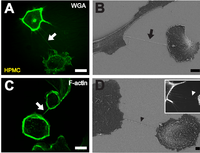Membrane nanotubes

Remember the long balloon animals that the clown made for you at your birthday party? Just like that, cells can also make long and skinny "balloons" called membrane nanotubes. These tiny tubes are actually walls made of the same material as the outside of the cell, and they can reach out to touch other cells or parts of the cell.
The nanotubes can be amazingly thin, like 1/1000th the thickness of the human hair. Sometimes, cells use these tubes to send small molecules or packages of proteins and DNA to other cells, almost like a secret message. For example, cells in our immune system use nanotubes to pass messages to each other and share important signals.
Overall, membrane nanotubes help cells communicate with each other and share important materials. They're kind of like tiny extensions that help cells reach out and touch each other.
The nanotubes can be amazingly thin, like 1/1000th the thickness of the human hair. Sometimes, cells use these tubes to send small molecules or packages of proteins and DNA to other cells, almost like a secret message. For example, cells in our immune system use nanotubes to pass messages to each other and share important signals.
Overall, membrane nanotubes help cells communicate with each other and share important materials. They're kind of like tiny extensions that help cells reach out and touch each other.
Related topics others have asked about:
